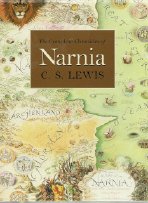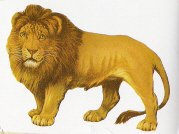Information
Contents
Foreword
Conclusion
C.S. Lewis's
Narnia Fairy Tales for Children
Information
Contents of the thesis
Foreword
Conclusion
Title: C.S. Lewis's Narnia Fairy Tales for Children
Author: Pirkko Anna Amnell ( Pirkko Pekkarinen)
Anna Amnell (Sanojen aika)
Level: Master's thesis
University of Helsinki
Faculty of Arts/Department of English
Spring 1970
Number of pages: 105
Where deposited: Arts Faculty Library
Key words: C.S. Lewis, The Chronicles of Narnia,
children's literature,
fantasy, fairy tales, Christianity
Abstract: not available
Other information:
CONTENTS OF THE THESIS:
FOREWORD 1
I INTRODUCTION 3
1. The fairy tale 3
2. Children's literature 9
II C.S. LEWIS 15
III THE STORIES OF NARNIA 22
A. THE ATMOSPHERE 22
1. The Dimensions of space 22
2. The Weather 25
3. Landscapes 25
4. The Sea 28
5. The Culture of England 29
6. The Invented Towns and cultural backgrounds 34
7. The Books and Music of the Narnian World 36
8. Paradise 39
9. Aslan's Land 41
B. THE CHARACTERS 44
1. The Sources of Characterization 44
2. The Methods of Characterization 49
3. The Categories of Characters 62
C. THE THEMES 65
1. The Good Old World 66
2. The Splendour 66
3. The Relationship of Men and Animals 70
4. Friendship and Membership 72
5. The Happy Opposition 75
6. The Black and White Magic 76
7. The Search for Joy 77
D. C.S. LEWIS'S THEOLOGICAL VIEWS 78
E. TECHNIQUE 85
1. Images for all the senses 85
2. The Manipulation of Time 90
3. The Humour 94
4. The Plot 97
CONCLUSION 100
BIBLIOGRAPHY 103
FOREWORD
One of the literary events of 1950 in England was the publication of The Lion, the Witch and the Wardrobe, the first in the series of the fantasy books for children by Clive Staples Lewis, an Oxford Don who was until then known as a writer of splendid literary criticism and apologetics. It is not strange in England that a learned man should write for children, as many of the great English children's books, especially in the field of fantasy, have been written by men who were distinguished in other fields than children's literature. For example, Lewis Carroll, author of the Alice-books, was in private life The Reverend Charles Dodgson, a professor of mathematics at Oxford; and Kenneth Grahame, author of The Wind in the Willows, held an important office in the Bank of England. It is generally thought that the sense of individualism among the English has made it easy and natural for them to regard children as individuals, important as such, not as miniature adults. For this reason the English are perhaps the best school masters in the world and can also produce excellent children's books.
In each succeeding year C.S. Lewis wrote a new book on the imaginary land of Narnia. For the seventh, The Last Battle (1956), but actually for the whole series, Lewis was awarded in 1956 the Library Association Carnegie Medal. The Carnegie Medal is annually given for "an outstanding book for children by a British subject domiciled in the United Kingdom (Great Britain and Northern Ireland) published during the preceding year." From this starting point I wish to find Lewis's place in the tradition of children's literature, to seek what has contributed to the special quality of his books, what makes them good and valuable to the whole field of literature.
Because C.S. Lewis has in his literary criticism often pointed to children\\\'s literature, both before and after writing such literature himself, it is interesting to parallel the theory and practice of Lewis in this question. Because the fairy tale is one of the less studied literary genres and because children's literature is a fairly new branch in literature as a whole, I feel it necessary to deal with some of the problems which have importance in studying Lewis's Narnia fairy tales.
CONCLUSION (pages 100-102)
During the last few decades more and more attention has been paid in all countries to children's literature. In this field, as in others, children must be given what is best for them.
Very often there has been criticism of romantic and moralizing books and children's writers have been challenged to write books near to everyday life. C.S. Lewis realized that he was writing for the generation which was born to the atomic bomb, "into a world of death, violence, heroism and cowardice, good and evil."
It is likely that the children will meet cruel enemies, therefore they should hear of brave knights and heroic courage. To prepare a child for life the writer need not handle questions which belong to the tangible everyday life, he can take a child on trips further than the moon, to the world of fantasy, and. still show him what is true of man's heart. C.S. Lewis thought also that children's books are an independent form of literature, not slaves to a programme of any kind.
But "the whole cast of the author's mind behind these books gives a special favour to the Narnia tales, the mind of a true scholar, one of the best-read men of his age, an excellent story-teller, a thinker and theologian" who has plumbed the depths of the dark void of atheism and come by the hardest route on his pilgrimage back to God. Christianity filled his mind: he did not put a moral in his stories; it was a natural part of his whole personality.
It gives a special light to the strange and beautiful world created by C. S. Lewis. The adventures are wild and even terrible at times, but there is always a trust, or at least a hope, that makes life wonderful.
Lewis is able to take the adult reader of his guard: things that have become too familiar to him are shown from a fresh aspect as if they were quite new. Perhaps children have a merely emotional understanding of what Lewis wants to say. But the magnificent scenes, wonderful actions and odd characters move them and can later be intellectually understood and the stories of our childhood are never forgotten by any of us. They are highly important in forming our whole outlook on life. Lewis's Narnia tales prepare the Child to receive Christian values and truths. They also arouse his curiosity towards all the great literary inheritance of mankind, and his willingness to 1ive a full and energetic life, complete with happiness and courage, heroism and friendship, respect for nature and humanity.
As an experienced writer Lewis could write in true tradition of the fairy tale, a story for children was to him like a new metre in verse that he carefully obeyed. He was able to tell adventures in a vivid, poetic style which also satisfies the critical adult reader. His lifelong interest in literature and training in criticism had given him knowledge of the factors that contribute to the high quality of a literary world. Therefore the Narnia tales can be assessed by the, rules applicable to all literature, merely keeping in mind certain special requirements.
Lewis's best qualities come out in these tales: high imagination, vast knowledge of literature, fresh and poetic style, profound morality. C. S. Lewis has been praised for his poetry and humour, for the richness of his scenery, and above all for the overwhelming joy that emerges from his stories. He has been able to give a dimension to reality in his imaginary country.
Adult criticism will not decide the future of these tales. Children themselves will decide generation after generation whether the chronicles of Narnia will keep a place in the literary treasure which they will carry lifelong in their hearts.





